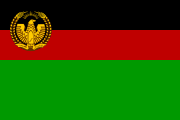This article relies largely or entirely on a
single source. (October 2014) |
National Revolutionary Party حزب اِنقلاب ملی | |
|---|---|
 | |
| Leader | Mohammed Daoud Khan |
| Founded | 1974 |
| Dissolved | 1978 |
| Headquarters | Kabul |
| Ideology |
Pashtun nationalism Pashtunization Pashtun Irredentism Authoritarianism Republicanism Progressivism Secularism |
| Political position | Big tent |
| Colors | Gold |
| Party flag | |
 | |
National Revolutionary Party ( Pashto: حزب اِنقلاب ملی, Hezb Enqilab Mili) was a political party in the Republic of Afghanistan. The party was founded in 1974 by President Mohammed Daoud Khan, who had seized control of Afghanistan from his first cousin, King Mohammed Zahir Shah, in the mostly bloodless 1973 coup d'état. [1]
The party was formed in an attempt by Daoud to garner support and grassroots backing for his republican regime. Daoud also intended the party to undermine support in Afghanistan for the People's Democratic Party of Afghanistan, who had actually helped him come to power in 1973. To this end, the party sought to be an umbrella organization for all of the factions of the progressive movement in Afghanistan. In order to help the party in its attempt to garner support, all other political parties were banned. [1] Despite the party being anti-communist, Daoud Khan demanded that members of the PDPA join the National Revolutionary Party and called for the dissolution of the Khalq and Parcham factions. [2]
The party was run by a central committee which comprised Major General Ghulam Haidar Rasuli, Defense Minister Sayyid Abd Ullah, Finance Minister Abd Ul Majid, and Professor Abd Ul Quyyum. [1]
The party did not survive the Saur Revolution in April 1978, which saw the overthrow and death of Daoud and his family, and the rise to power of the communist Khalqists belonging to the People's Democratic Party of Afghanistan. [1]
See also
References
- ^ a b c d Clements, Frank (2003). Conflict in Afghanistan: A Historical Encyclopedia. ABC-CLIO. p. 180. ISBN 9781851094028.
- ^ MSc, Engineer Fazel Ahmed Afghan (2015-06-12). Conspiracies and Atrocities in Afghanistan: 1700–2014. Xlibris Corporation. ISBN 978-1-5035-7300-0.